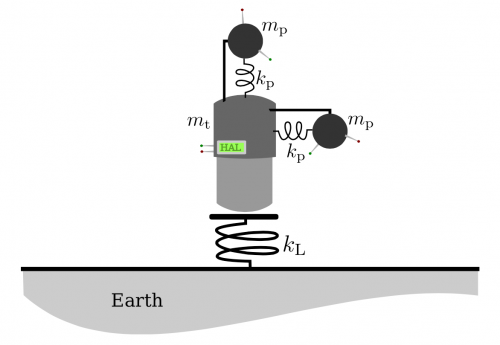Project 9: Part A: Launching a communications probe
You and your team are engineers that have been contracted by Elliot Carver of the Carver Media Group Network (CMGN) to plan the launch of their new “communications” satellite. The satellite is meant to perform a geosynchronous pole-to-pole orbit.
The satellite consists of a transmitter of mass ($m_t$ = 4500kg) connected to two perpendicularly directed ejectable spring-loaded probes (each having mass $m_p$ = 400kg). Each probe is connected to a single, very stiff spring ($k_p$ = $5.3\times10^9$ N/m). The probes can be ejected by remote control from the CMGN headquarters in Freer, Texas; springs can be compressed as needed. A mockup from CMGN's lead designer, Wai Lin, appears below.
CMGN is going green with their satellite launches. Their new design uses no fossil fuels. The satellite itself is launched from CMGN's launch facility in the South Pole with yet another spring system, oriented vertically with respect to the flat launching platform. This very stiff spring ($k_L$ = $8.3\times10^8$ N/m) can be compressed as needed.
The satellite contains a gyroscope that self-orients the satellite with respect to the gravitational force due to the Earth, such that the satellite remains in its original orientation throughout the entirety of its trip.
Carver needs you to plan the launch and any subsequent course corrections needed to get the satellite into a geosynchronous pole-to-pole orbit.
Project 9: Part C: Saving a probe
You need to recover HAL. HAL, if you remember, was a part of the satellite ($m_{\rm t}=4500\,{\rm kg}$) that the Carver Media Group Network (CMGN) launched. The satellite (and HAL) was designed to communicate with Earth out to a distance of 3.8 million kilometers. As part of the electronics HAL contains a green and a red light-emitting diode (LED) mounted on the outer surface of the satellite. One of the probes ($m_{\rm p}=400\,{\rm kg}$) remains attached to a single, very stiff spring ($k_{\rm p}=5.3\times10^{9}{\rm N/m}$) that can be compressed remotely and then released to fire off the probe. You have hacked into this remote firing mechanism.
Unfortunately, a transcription error was made by Mr. Stamper, Carver's chief “engineer” when the satellite was initially launched. As a result, the satellite escaped Earth's gravity and is currently traveling in a straight line away from the Earth at a distance of 1.9 million kilometers. Its speed is nearly constant at $340\,{\rm m/s}$. The gyroscope system that keeps the orientation of the satellite constant is still working. However, an asteroid ($m_{\rm a}=9300\,{\rm kg}$) traveling at a speed of $950\,{\rm m/s}$ is on a direct collision course (in line with the Earth and HAL) and the collision is imminent. The asteroid is presently 500 kilometers from the satellite.
Your team can recapture the satellite if it can be returned to Earth. You should design a way to return the satellite to Earth. You will also need to ensure the asteroid will not collide with the satellite - damaging the probe is ok. Your team also needs to determine the minimum amount of time until the possible collision to determine if a communication from Earth can be completed in time.

